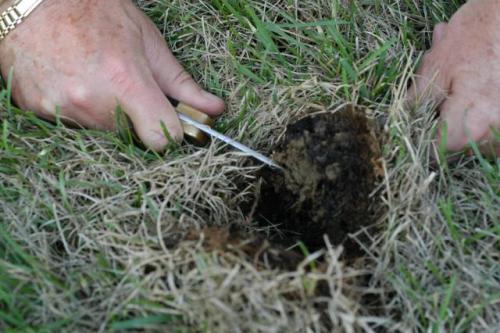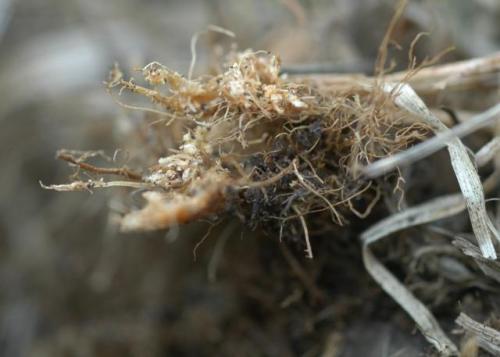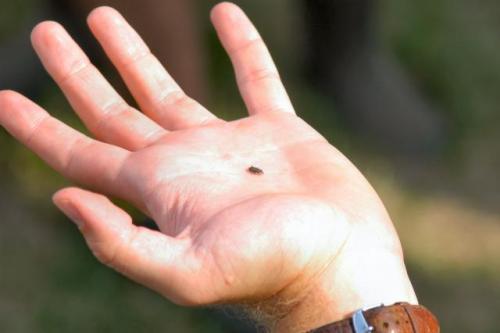Bulletin E0025TURF
Bluegrass Billbug
May 28, 2015 - D. R. Smitley
The bluedgrass billbug, Sphenophorus parvulus, is a weevil that occasionally causes extensive damage to home lawns in Michigan. These beetles are named because of their long snout or "bill" which ends in a set of small mandibles or jaws. Migrating adult billbugs may be seen in May or August on sidewalks, driveways or patios.
Billbugs in the lawn are generally not detected until the first signs of damage appear in July.
Circular to irregularly shaped dead pathes of turf scattered throughout the lawn in July and August.
- Hosts: The bluegrass billbug most commonly attacks Kentucky bluegrass, Poa pratensis, but may be found in some fescue and perennial ryegrass lawns. The bluegrass cultivars Merion, Nugget, Windsor, Sodco, Kennblue, and Pennstar are especially susceptible to injury. Delta, Park, Ram 1, Touchdown, Fylking, Newport, and Nudwarf have some resistence.
- Damage Symptoms: Circular to irregularly shaped dead pathes of turf scattered throughout the lawn in July and August are characteristic of billbug damage.
- Similar Damage: Damage caused by a high infestation of billbugs is similar to that caused by white grubs (beetle larvae). However, grub-damaged turf can be pulled up like a carpet to reveal white C-shaped larvae. Billbug damage is usually more localized and may first appear in September and October, while billbug damage occurs in late July.
- Identification: Adult billbugs are dull gray to black beetles, ¼ to ½ inch long, with a snout or bill. Billbug larvae are white, legless, 5/8-inch long, humpbacked grubs with a yellow to brown head, which is harder in texture than the soft white body.
- Destructive Stages: Adults feed on grass blades or stems, but the major damage is caused by larvae feeding inside the stem, at the crown or on roots.
- Life Cycle: Billbugs overwinter as adults and become active as temperatures begin to warm in April. Although some eggs are laid in grass stems in May, most are deposited in early June. Egg hatch occurs in one to two weeks, and the larvae tunnel down through the grass stems into the crown and eventually settle in the roots. Mature larvae feed on turfgrass roots and stems, often cutting the stems off at the crown so injured grass plants are easily pulled up.
Larvae may be present throughout the summer in small numbers. Peak density occurs in July. Adults that have overwintered may persist all summer but the new generation of adults (which will lay eggs in the spring) begin to emerge from small cells in the soil in early August. Soon after emerging, they seek out sheltered areas to spend the winter and an be observed on sidewalks, driveways and patios and near ground covers. There is only one generation per year.
Diagnosis of Billbug Damage
The following signs can be used to diagnose billbug injury:
- Circular to irregular patches of dead grass, especially near sidewalks of curbs.
- Grass in dead areas of lawn pull up easily and has hollow stems.
- A white, legless, humpbacked larva present in or under the plant crown or in the soil as deep as one inch.
- Yellow sawdustlike frass in the root zone.
- Adults present in adjacent grass.

Grass in dead areas of lawn pull up easily and has hollow stems.
Management
The period from July to early August is the most critical time for turf to be damaged by bluegrass billbug. At this time feeding activity is greatest and the turf is frequently under moisture stress.
Maintaining adequate soil moisture and nutrient levels during stress periods will maximize turfgrass vigor. Consequently, billbug damage will be less severe and the use of chemical pesticides may not be required.

Yellow sawdustlike frass in the root zone.
Preventative applications of insecticides are not recommended because insecticides destroy predators and parasites that help keep billbug populations under control.
Only heavily infested lawns should be treated with insecticide. Check lawns for billbugs by looking for turf injury in late July. Lawns injured by billbug should be targeted for an insecticide application in June of the following year. Choose an insecticide that is effective against grubs and other soil insects. Follow the insecticide application with ½ inch of irrigation to move the insecticide into the soil. If billbug damage is limited to certain areas of the lawn, only treat those areas.
Insect parasitic nematodes have been effective for control of billbug larvae when applied in late June or early July. Apply the nematodes as a spray in early morning or evening. Irrigate the turf with ½ inch of water before the nematodes are applied and apply another ½ inch of water afterward.

Adults present in adjacent grass.



 Print
Print Email
Email

